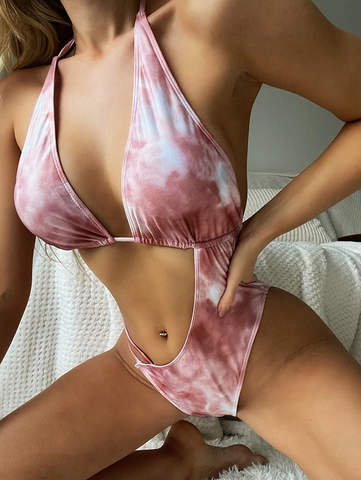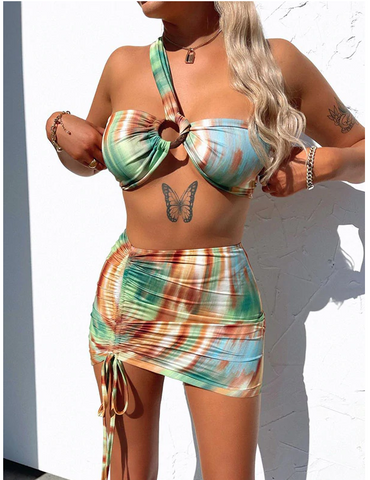
How to Choose Swimsuits
Share
Whether you're stand-up paddle boarding or swimming in the pool, you'll want a suit that fits, moves with you and stays put. Finding the right sports suit depends on a number of personal choices: how much exercise you plan to do, how much support you need or how much skin you want to show. Fortunately, with a wide range of styles, patterns and silhouettes, it's easy to find one that looks good and works.
Consider these four factors when choosing a swimsuit for your favorite water activity:
Choose your swimsuit style according to your activities: how you will exercise and how much sunlight you will face will help guide your choices. If you spend a lot of time avoiding the waves, choose a one-piece swimsuit or a top with an I-shaped back or thick cross straps, so you will very stay secure.
Decide what coverage you want and where you want to go: For example, if you plan to sunbathe and snorkel on the beach, you can choose a rashguard and board shorts, and when you're ready, you can limit your sun exposure by wearing a sports bikini.
Determine the fabric you want and design features: Quick-drying fabrics allow you to easily go from playing in the water to lounging around the pool. Zipper board short pockets for easy storage of essentials while you are on the paddle board.
Look for a comfortable style: You want to spend more time focusing on your water activities, not less time adjusting your hips or making sure your top stays in shape. Whenever possible, it's best to try on a suit and walk around in it to find the right fit and make sure it doesn't ride up.

Type of swimsuit
One-piece suits: They've come a long way in style and functionality. Because most sports-style one-pieces are easier to fix than two-pieces, they're a great choice for sports like scuba diving, body surfing, or stand-up paddle boarding, as you'll spend a lot of time jumping into the water or waves. If you plan to do a lap or competitive swim, you can opt for a form-fitting, cross-backed, streamlined swimsuit that reduces trouble and drag in the water.
Two-piece women's suits: Swimming top and bottoms are sold separately and it's easy to customize a two-piece suit to suit your water sport and body type. Many active brands have designed two-piece performance to stay the same in many water sports. When going to the bathroom, two pieces are more convenient than one-piece.

There are two main categories of tops for two-piece swimsuits:
Bikini: This includes a classic triangle top, bra or corset-style top.
Tankini: These vests usually cover the entire abdomen (crop tops can be somewhere in between).
Bathing trunks cover a wide range of areas, from traditional bikini bottoms with higher legs to more extensive bathing trunks. Other areas covered include swimming skirts and boys' short styles.
Men’s swim trunks: Casual swimming trunks or swimming trunks, ranging in length from short to above the knee. They usually have drawstrings, buckles, or elastic bands; Some come with a mesh inside brief or extra support lining. You can choose a fitted or loose-fitting style.
Men's swimming briefs: This is a slim-fitting, triangular swimsuit, usually worn in performance sports, such as knee swimming and water polo, where speed and free movement are essential.
Swim leggings: These long swimming trunks, also known as swim tights, provide maximum sun protection from the waist down to the calves or ankles. They’re is a great option for paddling, surfing, snorkeling, or other sports that expose you to a lot of sun and water and don't want to constantly reapply it. Depending on the fabric, they can keep you warm in cold water.
Board shorts: These shorts vary in length. Some women's board shorts quite short (2 inches inseam), while some men's board shorts well below the knee to help protect the thighs from surfboard or paddleboard friction.
Jammers: These snug-fitting shorts hug thighs and bottom (they’re similar to a bike short without the padding). They’re great for lap or competitive swimming because there’s minimal drag.
Jammers: These tight shorts cling to the thighs and hips (they’re similar to a bike short without the padding). They’re great for lap or competitive swimming because there’s minimal drag.
Rashguards: These trendy shirts can protect you from the sun. Rashguards shield can protect you from uv rays while boating, surfing, snorkeling or swimming for long periods of time. They are light and stretchy and can be loose or fitted. Shirts come in a variety of styles - cap sleeves, short sleeves, three-quarter lengths, long sleeves, pullovers or zip-up shirts.

Features to Consider in Active Swimwear
Fast-drying fabric. If you plan to spend a lot of time in and out of the water, consider opting for a quick-drying suit. Quick-drying suits also help prevent chafing, as they absorb moisture from the skin. Thicker fabrics or cotton-blended suits may not dry as quickly.
Sun-protective fabric. Sun-protective fabric can help protect you from uv rays, which can cause sunburn. Clothing's UPF rating ranges from 15 to 50+, depending on its ability to resist ultraviolet A (UVA) and ultraviolet B (UVB) rays. The higher the UPF number, the stronger the protection.
Inner liners: Some men's trunks will have an internal lining or other lining to help prevent chafing and provide extra coverage. Women's suits may have linings to be more opaque when wet, and some have special linings to help the suit stick to the skin and prevent slipping.
Removable bra cups: Some women prefer the enhanced silhouette and conservative effect of padded bra cups, but those who don't can easily remove them.
Pockets: Swim shorts have zip pockets on the side or back, or mesh pockets inside that allow you to store a car key, lipstick, or other small essentials while doing sports like paddling or kitesurfing.
Swimsuit strap Style: Women's swimsuit straps can be stylish, but their function is essential for active sports. When choosing a suit, keep in mind that wide straps are generally more comfortable than narrow ones and often provide better support.
Adjustable straps: Adjustable straps allow you to loosen or tighten the straps to fit your specific body and come in handy when straps loosen with use.
Back closure: Bathing suit tops with back closures can make tops easier to put on and remove, especially when the fabric is wet.
Adjustable straps: Adjustable straps allow you to loosen or tighten them to fit your particular body and come in handy when the straps loosen.
Back closure: The closed back of a bathing suit top makes it easier to put on and take off, especially when the fabric is wet.
Racerback/Cross: These strap styles allow a good range of motion for the arms and shoulders while maintaining a safe fit.
Halter: The straps on suspenders are tied around your neck and are a great support option for those with larger breasts (although be aware that they can also cause some discomfort around the neck).